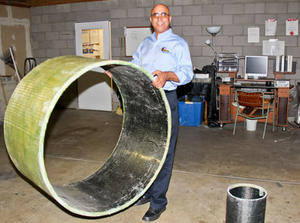InfrastructureAerospace materials for on-site building of pipes of infinite length
Concrete and steel pipes are built in short sections to fit on standard 18-wheel trucks; the heavy industrial manufacturing processes, long-distance trucking, and leak-prone joints used in steel and concrete pipe construction exact a heavy toll on the environment, not to mention bottom line; the solution: a new pipe design, consisting of a central layer of lightweight plastic honeycomb, which can be built onsite as a single section of virtually infinite length

Developer Mo Ehsani with a section of his InfinitPipe // Source: arizona.edu
Carbon fiber fabric and lightweight honeycomb materials, plus mobile manufacturing platform, make infinite pipeline technology cheaper and greener while boosting local economies.
Mo Ehsani, Professor Emeritus of Civil Engineering at the University of Arizona, has designed a new, lightweight underground pipe he says could transform the pipeline construction industry.
A University of Arizona release reports that instead of conventional concrete or steel, Ehsani’s new pipe consists of a central layer of lightweight plastic honeycomb, similar to that used in the aerospace industry, sandwiched between layers of resin-saturated carbon fiber fabric.
In combination, these materials are as strong, or stronger, than conventional steel and concrete pipes, which are time-consuming and expensive to manufacture and transport.
Concrete and steel pipes are built in short sections to fit on standard 18-wheel trucks, but Ehsani’s new pipe can be built onsite as a single section of virtually infinite length, hence the product name InfinitPipe.
The heavy industrial manufacturing processes, long-distance trucking, and leak-prone joints used in steel and concrete pipe construction exact a heavy toll on the environment, not to mention bottom line, which is why Ehsani’s company, QuakeWrap, is marketing InfinitPipe as the world’s first “green” pipe.
“There are really two aspects to this invention,” Ehsani said. “One is this new type of lightweight honeycomb pipe. Second is our ability to give clients an endless or infinite pipe, without a joint. That is a big, big breakthrough in the pipeline industry that has implications for natural gas, oil, water, and sewer pipes.”
A literally infinite pipe is, of course, not feasible, but Ehsani’s method of manufacturing could create extremely long sections of joint-free pipe. “We could make a section a mile long,” he said. “Of course, every thousand feet or so, you’d need an expansion joint so the pipe can breathe, but this would certainly not be the same concern we have today, where we have to put a joint every 20 feet.”
The release notes that the secret of producing virtually endless pipe sections lies in the manufacturing methodology.
Ehsani wraps the various layers of carbon fabric and honeycomb around a mandrel, a kind of tubular mold with a cross-sectional shape that matches the pipe’s internal cross-section, which is typically, but not always, circular.
“We basically start with a tube and wrap the materials on the outside,” Ehsani said. “A couple of layers of carbon fabric, then we put on the honeycomb and then a couple of layers of carbon or
